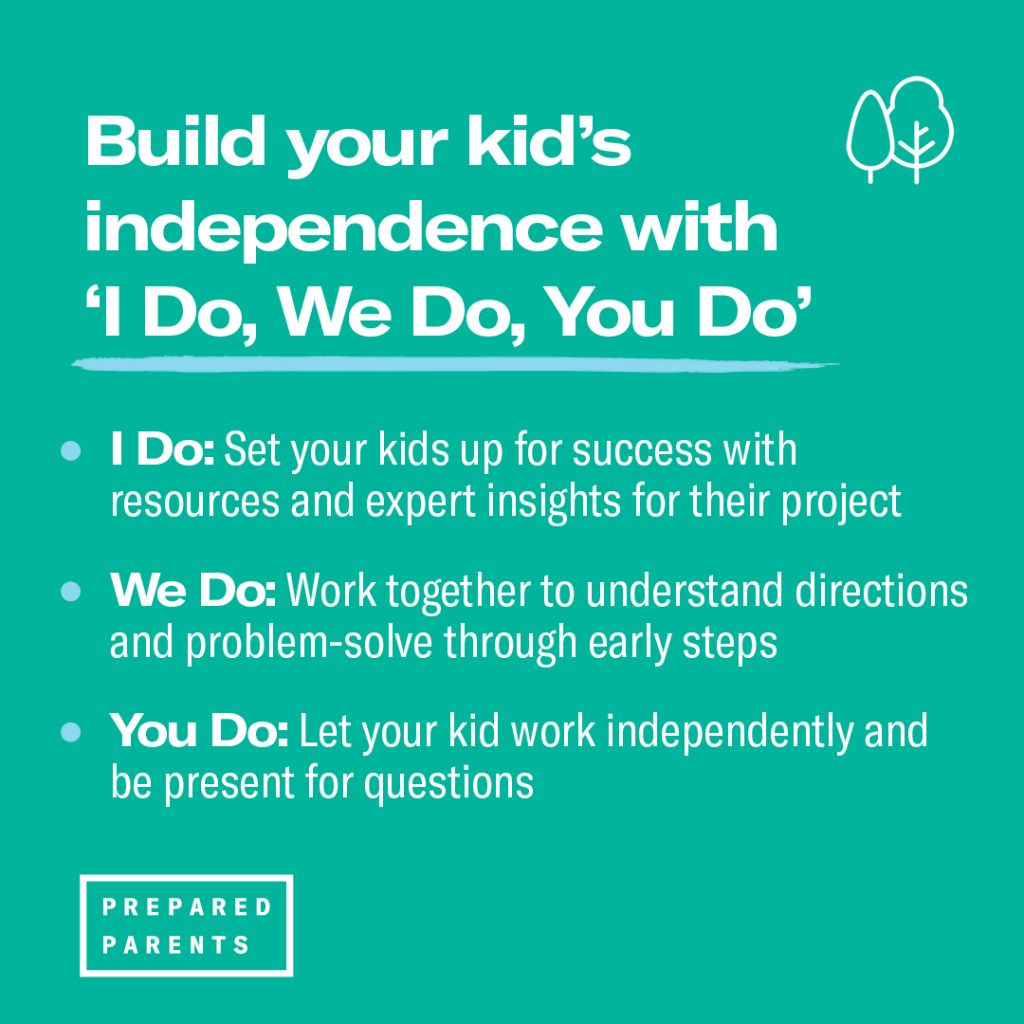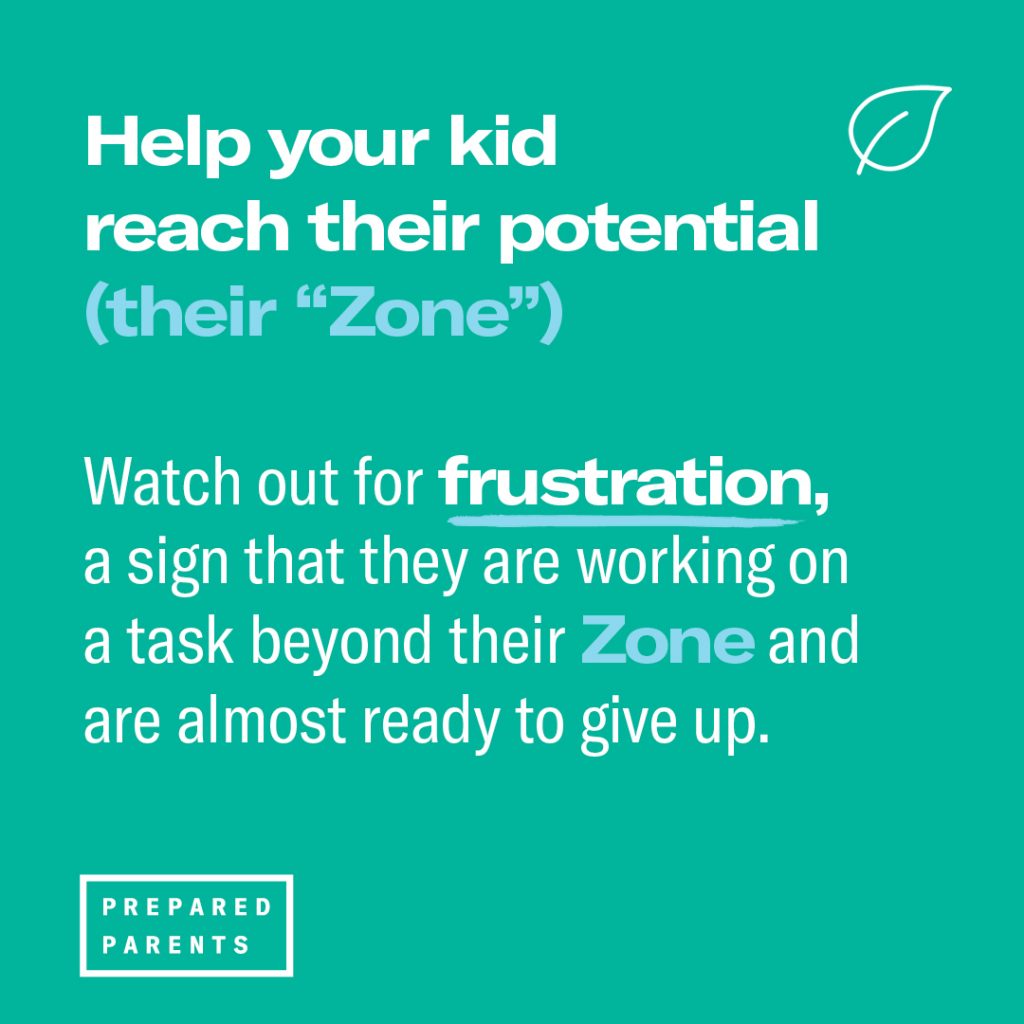Would you throw your kid into the deep end of the pool to teach them how to swim? Of course not! You’d provide instruction and support, gradually letting them build strength and skill until they’re swimming on their own. The same ideas apply to any learning task, and that is where I Do, We Do, You Do comes in.

Kids are able to learn best when they are challenged just enough to learn new skills, but aren’t pushed past what they are ready for. When we hear from our kids the infamous “I can’t!” or “This is too hard!,” we often think they may not be trying hard enough. But there is actually a delicate balance at play here, where we can help our kids through “productive struggle” to get into their sweet spot of learning.
One approach expert educators use to lead kids to new learning is I Do, We Do, You Do, a method of modeling and then gradually giving kids more and more responsibility to complete tasks or understand concepts on their own.

Teachers use a concept called “scaffolding” to break work into manageable “chunks.” The term scaffolding in instruction originated with Jerome Bruner, a cognitive psychologist in the middle of the 20th century. Scaffolding describes the idea that the right support, tailored to the individual learner, helps the learner acquire new knowledge.
Scaffolding is meant to help students stay in their “sweet spot” of learning, also known as the “zone of proximal development,” or ZPD. The concept of Zone of Proximal Development was developed by psychologist Lev Vygotsky in the 1930s.
Scaffolding can take numerous different forms; I Do, We Do, You Do and chunking are just two.
I Do, We Do, You Do has three phases (I, We, You). The length of each phase varies: the further an activity is from a kid’s current ability and the complexity of the activity itself will influence how quickly the phases progress. The goal is for a kid to apply a skill, concept, or habit with independence in any context.
For example, it’s one thing for a kid to solve a math problem in a workbook in their bedroom with no time limit, but could they do it independently as part of an oral exam in front of 40 peers, with the clock ticking? Independence doesn’t come easily! So, while the process seems linear, expect some repetition, especially as content and skills become more complex.
When using I Do, We Do, You Do, focus on key elements of the concept or skill that can be separated into manageable parts. This chunking has numerous benefits:
- It keeps motivation high by instrumenting quick wins.
- It allows you to provide support when it’s needed, while encouraging independence for manageable parts.
- It helps the learner gain knowledge, skill, and confidence, so they’re gradually able to accomplish tasks independently.
The I Do step lets you set the stage for kids’ success by demonstrating a skill or concept yourself first.
How to do it:
- Plan ahead. Even if you already have everything you need to demonstrate, it’s helpful to model an assessment of what you need as you approach a new concept or skill. Think out loud: “What do I need to understand about this? What steps should I take? What tools do I need to complete this task?”
- Be the expert, or find an expert. If you don’t have the skills and knowledge you need to provide an effective demonstration, find— or help your kid find—an expert, such as, for example, a reliable YouTube video.
- Think out loud. As you explain the concept or demonstrate the skill—chunking the content into manageable bits—think out loud, so kids really get a sense of what mental steps you’re taking as you do the work and why you’re taking each step. Through this think-aloud, you’re offering kids the steps they can use for deliberate practice. For example, “First I need to understand X so I can…. Now that I know that, I can look at Y. I’m wondering Z, and these are my options…”
- Ask the right questions. If you’re reviewing expert information or a video with your kid, pause to demonstrate the type of thinking you want them to do as they encounter new content. For example:
- What were the steps in the expert’s process?
- What previous knowledge was it important to understand?
- What tools or theories did the expert use?
Once you’ve effectively modeled the activity or observed an expert demonstration, you’re ready to encounter the next stage in the process.
In this stage, you’re the tutor, walking the kid through achievable steps (your chunks!) and asking questions along the way to reinforce understanding.
Don’t provide all of the answers.
Ask questions to get kids thinking and to lead them through the process. When kids get totally stuck, you might back up and try I Do again, to provide another example.
The goal of We Do is to enable the student to accomplish the tasks or understand information on their own—so it’s important to gauge their ability on each part and provide support as needed. The support keeps the struggle productive and within that sweet spot of learning.
It’s time to let your kid give it a go independently, while you stay present. Let your kid know that they’re on their own, but you’re around if they have questions. You still have a role:
Keep watch without jumping in.
You can keep an eye on how things are going, and you can be there to help out, but let your kid have some space. It’s important that you don’t jump in because your child isn’t doing things your way. Learning is filled with small mistakes, and we’re often our own best teachers.
Watch out for frustration.
Be on the lookout for frustration, a sign that a kid might need more support and may be ready to give up. You’ll recognize frustration when kids stop working on a task and express anger—at themselves, at the task, or at objects. When you notice frustration, listen, offer strategies, and be a guide. Start with “I noticed…” to kickstart an intervention: “I noticed you sound frustrated. Is everything okay? How are you feeling?”
Remember, learning takes time.
I Do, We Do, You Do is an effective approach, widely used by great teachers and coaches. But as with all growth, it doesn’t happen overnight! It’s important to be patient and persistent.
It can be hard as an adult when you’ve shown a kid something, you’ve had a conversation about how you did it, and you’ve done it together, and still,
they remain unable to do it on their own. But what seems like a linear process quite often goes in circles.
Hang in there! When you’re using chunking to scaffold a kid’s learning, you have to allow time for the step of integration, in which the learner puts all the parts together and is able to perform the complete skill on their own.

